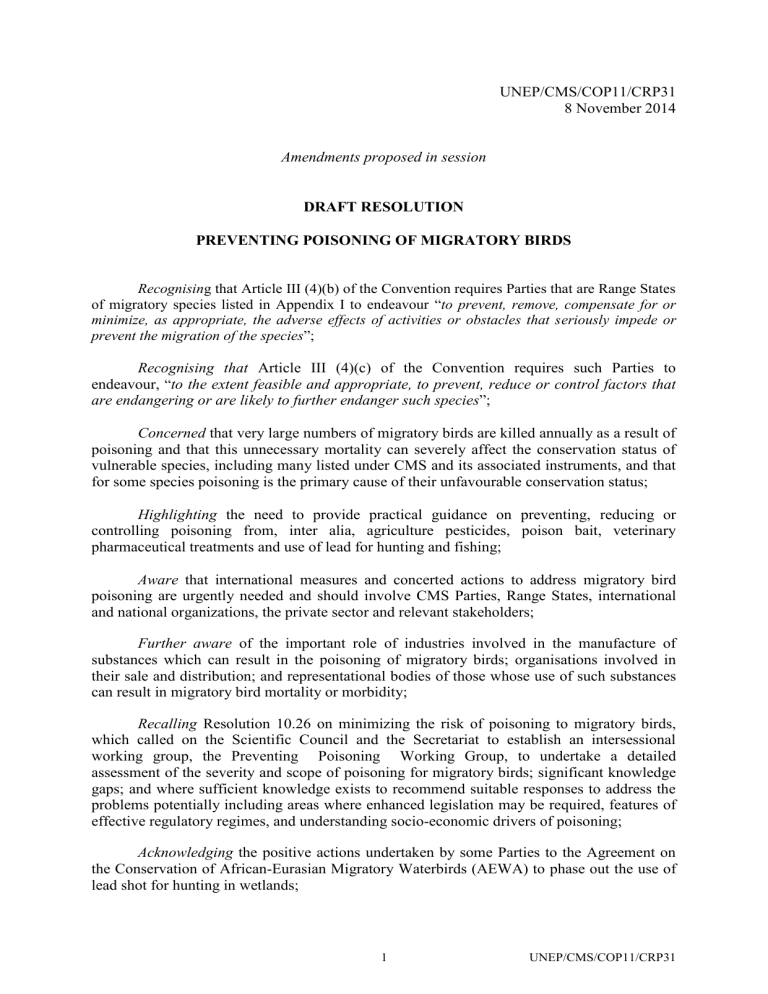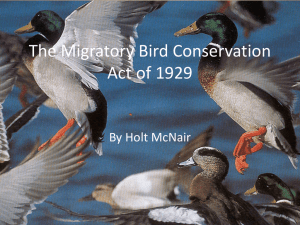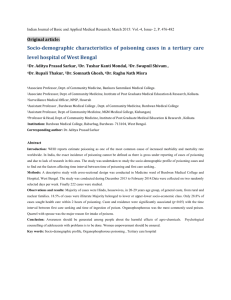Draft Resolution Preventing Poisoning of Migratory Birds

UNEP/CMS/COP11/CRP31
8 November 2014
Amendments proposed in session
DRAFT RESOLUTION
PREVENTING POISONING OF MIGRATORY BIRDS
Recognisin g that Article III (4)(b) of the Convention requires Parties that are Range States of migratory species listed in Appendix I to endeavour “ to prevent, remove, compensate for or minimize, as appropriate, the adverse effects of activities or obstacles that seriously impede or prevent the migration of the species ”;
Recognising that Article III (4)(c) of the Convention requires such Parties to endeavour, “ to the extent feasible and appropriate, to prevent, reduce or control factors that are endangering or are likely to further endanger such species ”;
Concerned that very large numbers of migratory birds are killed annually as a result of poisoning and that this unnecessary mortality can severely affect the conservation status of vulnerable species, including many listed under CMS and its associated instruments, and that for some species poisoning is the primary cause of their unfavourable conservation status;
Highlighting the need to provide practical guidance on preventing, reducing or controlling poisoning from, inter alia, agriculture pesticides, poison bait, veterinary pharmaceutical treatments and use of lead for hunting and fishing;
Aware that international measures and concerted actions to address migratory bird poisoning are urgently needed and should involve CMS Parties, Range States, international and national organizations, the private sector and relevant stakeholders;
Further aware of the important role of industries involved in the manufacture of substances which can result in the poisoning of migratory birds; organisations involved in their sale and distribution; and representational bodies of those whose use of such substances can result in migratory bird mortality or morbidity;
Recalling Resolution 10.26 on minimizing the risk of poisoning to migratory birds, which called on the Scientific Council and the Secretariat to establish an intersessional working group, the Preventing Poisoning Working Group, to undertake a detailed assessment of the severity and scope of poisoning for migratory birds; significant knowledge gaps; and where sufficient knowledge exists to recommend suitable responses to address the problems potentially including areas where enhanced legislation may be required, features of effective regulatory regimes, and understanding socio-economic drivers of poisoning;
Acknowledging the positive actions undertaken by some Parties to the Agreement on the Conservation of African-Eurasian Migratory Waterbirds (AEWA) to phase out the use of lead shot for hunting in wetlands;
1 UNEP/CMS/COP11/CRP31
Further recalling that the Memorandum of Understanding on the Conservation of
Migratory Birds of Prey in Africa and Eurasia highlights the many African-Eurasian migratory raptors with an unfavourable conservation status at a regional and/or global level as a result of poisoning;
Noting the objectives of the Rotterdam Convention on the Prior Informed Consent
Procedure for Certain Hazardous Chemicals and Pesticides in International Trade, which promotes the environmentally sound use of hazardous chemicals and shared responsibility to protect the environment from harm;
Noting with satisfaction Recommendation 164 (2013), adopted by the Standing
Committee to the Convention on the Conservation of European Wildlife and Natural Habitats
(Bern Convention), which raises concern regarding the widespread use of poisons to kill protected species, and calls for a strengthened cooperation to enhance national and international actions to eliminate this damaging practice;
Recalling the Ramsar Convention’s Resolution XI.12 on ecosystem approaches to wetlands and health which recognizes the interactions between disease - including poisoning - in wildlife, human and domestic animals, which stressed the urgent need to ensure that policy responses are better integrated in a ‘One Health’ approach across these sectors for most effective outcomes;
Recognizing that whilst activities associated with some substances toxic to birds can have social and/or economic significance, such as the protection of agricultural crops from pests, experience shows that strategies to minimize and prevent the risk of poisoning of birds can be, nonetheless, sustainably implemented with benefits to the provision of wider ecosystem services;
Recognizing that under strictly supervised conditions and on a selective basis, the legal and regulated use of poison baits can have important conservation benefits through the control of alien invasive species;
Concerned that there is a serious geographical bias in relevant research and knowledge, and emphasizing that further research on and monitoring of migratory birds and sources of poisoning are urgently required for some poisoning sources, and that studies should be designed so as to better assist in formulating and monitoring policy;
Acknowledging that a number of Parties are already applying relevant policies, for example, removal of certain toxic agricultural insecticides from the market, implementing programmes of Integrated Pest Management, and promoting the use of non-toxic ammunition for hunting, and commending those Parties for such actions;
Noting the UNDP/GEF 'Migratory Soaring Birds Project' implemented by BirdLife
International, which aims to ensure that the conservation needs of migratory soaring birds are addressed by industry, including the agriculture sector, along the Red Sea/Rift Valley Flyway, and recognizing the potential this project has to promote the implementation of this
Resolution and associated Guidelines nationally and locally;
Stressing that capacity building at national and regional level is of fundamental importance for the effective implementation of this Resolution;
2 UNEP/CMS/COP11/CRP31
Acknowledging with thanks the Government of Tunisia for hosting the workshop held in Tunis from 27-31 May 2013 to assess the severity of poisoning and to discuss guidelines, and the generous financial support provided by the Government of Switzerland and the
European Science Foundation towards the organization of this workshop; and
Taking note of the “Review of the ecological effects of poisoning on migratory birds”
(UNEP/CMS/COP11/Inf.34) and thanking the Preventing Poisoning Working Group members, the Coordinator and the CMS Secretariat for their contributions to the production of this document;
The Conference of the Parties to the
Convention on the Conservation of Migratory Species of Wild Animals
1.
Adopts the “Guidelines to Prevent the Risk of Poisoning of Migratory Birds” (the
Guidelines) contained in document UNEP/CMS/COP11/Doc.23.1.2/Annex 2, agreeing that it is for each Party to determine whether or how to implement the recommended actions, considering the extent and type of poisoning risk, whilst having regard to their international obligations and commitments, including those under the Convention;
2.
Urges Parties and encourages non-Parties to disseminate and implement these
Guidelines, as appropriate, across all flyways, where necessary translating the Guidelines into different languages for their wider dissemination and use;
3.
Encourages CMS Parties and invites Parties and Signatories of CMS Family instruments to identify within flyways, those geographical areas where poisoning is causing significant migratory bird mortality or morbidity, and address these as a matter of priority applying the Guidelines as appropriate;
4.
Urges the Secretariat to consult regularly with relevant stakeholders, including government agencies, scientific bodies, non-governmental organizations and the agricultural, pharmaceutical, hunting and fishing sectors, in order to monitor the impacts of poisoning on migratory birds and to support the elaboration of national strategies and sector implementation plans as necessary;
5.
Encourages CMS Parties to monitor and evaluate the impact of poisoning on migratory bird species regularly at national level, as well as the effectiveness of measures put in place to prevent, minimize, reduce, or control poisoning impacts, as appropriate;
6.
Calls on Parties and non-Parties, including inter-governmental organisations and other relevant institutions to elaborate strategies to address poisoning or to include measures contained in this Resolution and in the Guidelines in their National Biodiversity Strategies and Action Plans (NBSAPs) or relevant legislation as appropriate to prevent, minimize, reduce or control the impact of poisoning on migratory bird species;
7.
Instructs the Secretariat, in close cooperation with relevant CMS instruments, to liaise with the Bern Convention Secretariat and other relevant international organizations in order to update the Guidelines as necessary, and invites Parties to contribute to the dissemination and updating of the Guidelines;
3 UNEP/CMS/COP11/CRP31
8.
Invites the Rotterdam Convention on the Prior Informed Consent for Certain
Hazardous Chemicals and Pesticides in International Trade to cooperate actively with CMS on matters related to poisoning of migratory birds, and in particular on the question of clarifying existing guidelines used in decision-making processes under that Convention as appropriate;
9.
Invites the International Cooperation on Harmonisation of Technical Requirements for
Registration of Veterinary Medicinal Products (VICH) and the Organisation for Economic
Cooperation and Development (OECD) to consider conducting an evaluation of the risk that veterinary medicinal products pose to scavenging migratory bird species through either lethal or sub-lethal impacts, and using the results to provide guidance to the veterinary sector;
10.
Encourages all those concerned with preventing poisoning of migratory birds to engage with such groups and create active partnerships – at appropriate scales – as a priority in implementing the Guidelines;
11.
Invites Parties to note that neonicotinoid insecticides have become a main replacement for the organophosphates and carbamates reviewed; and to consider conducting further research on and monitoring migratory bird mortality incidents associated with the use of these and other insecticides;
12.
Instructs the Secretariat, in collaboration with Parties and relevant international organizations, subject to the availability of funds, to organize regional workshops in high risk areas/flyways to promote the implementation of the Guidelines and to share best practice and lessons learnt;
13.
Calls on Parties and invites non-Parties and stakeholders, with the support of the
Secretariat, to strengthen national and local capacity for the implementation of this Resolution including, inter alia , by developing training courses, translating and disseminating examples of best practice, sharing protocols and regulations, transferring technology, and promoting the use of online tools to address specific issues that are relevant to prevent, reduce, or control poisoning of migratory birds protected under the Convention;
14.
Urges Parties, UNEP and other relevant international organizations, as well as the industry, bilateral and multilateral donors and others, to consider supporting financially the implementation of this Resolution and the Guidelines, including through the coordination provided by the Preventing Poisoning Working Group, support of regional workshops, and the provision of financial assistance to developing countries for relevant capacity building;
15.
Proposes the continuation of the open-ended Preventing Poisoning Working Group until COP12 with Terms of Reference in Annex 2, renewing its membership to incorporate expertise from geographical regions currently absent as well as representatives of industry and governments, to address the impact of other sources of poisoning, and geographic gaps, and to monitor the implementation of the Guidelines; and
16.
Calls on Parties to report progress in implementing actions taken under this
Resolution, and results achieved to future COPs through their National Reports.
4 UNEP/CMS/COP11/CRP31
GUIDELINES TO PREVENT THE RISK OF
POISONING TO MIGRATORY BIRDS
Annex 1
5 UNEP/CMS/COP11/CRP31
Annex 2
TERMS OF REFERENCE OF THE PREVENTING POISONING WORKING GROUP
(for the intersessional period until COP 12)
1. Background and purpose
This Working Group was established by Resolution 10.26
1
to assist the Parties to the
Convention on Migratory Species (CMS) and its associated instruments, relevant MEAs and
Conventions to review the causes and consequences of poisoning of migratory birds, and to recomend suitable responses to address the problems.
2. Role & Scope
The role of the Working Group is to facilitate concerted efforts, actions and procedures to prevent poisoning of migratory birds. Its geographical scope is global. The Working Group will cover all migratory bird taxa as identified by CMS and its relevant associated instruments.
3. Remit
The Working Group will:
Support implementation of the Preventing Poisoning Guidelines a.
Facilitate implementation of the Preventing Poisoning Guidelines and other relevant
Resolutions adopted by CoP 11 as well as other relevant frameworks for action; b.
Set and implement priorities for its work; c.
Keep the Guidelines actively under review in the light of developing research findings and other relevant information and report relevant developments to the Scientific
Council; d.
Assist in resource mobilization for priority actions; e.
Actively seek engagement from and with relevant agrochemical, veterinary pharmaceutical industries, and companies manufacturing lead ammunition or fishing weights; f.
Review, take account of, and communicate best practice when poisons are used as management tools in the protection of migratory birds and other biodiversity; g.
Encourage the translation and dissemination of the Guidelines widely within relevant networks, as well as to end-users and others;
1 Under the name Minimising the Risk of Poisoning to Migratory Birds Working Group.
6 UNEP/CMS/COP11/CRP31
h.
Monitor the implementation of the relevant decisions and plans and their effectiveness and submit progress reports to the governing bodies of the participating MEAs; i.
Stimulate internal and external communication and exchange of information, experience, best practice and know-how; and j.
Strengthen relevant regional and international networks.
Assess other causes of migratory bird poisoning k.
Resources permitting, consider the need for additional guidance for preventing impacts on migratory birds from other types of poison (for example pheromone-type substances) and geographic gaps, and how these might be developed;
For effective working, the Working Group will establish task groups addressing either thematic issues (e.g. for different poison types) and/or geographical regions to progress its work.
4. Membership
The membership of the Working Group will comprise the Secretariats of the participating
MEAs, as well as academic institutions, NGOs and other stakeholders, as appropriate.
The following representatives will also be invited to contribute to the Working Group:
Representatives of CMS Parties;
Representatives of the CMS Scientific Council, AEWA Technical Committee, Raptors
MOU Technical Advisory Group, Bern Convention Expert Group on Birds;
Representatives of the CMS Mediterranean Illegal Killing, Taking and Trade Task
Force, African-Eurasian Migratory Landbird Working Group and Flyways Working
Group; and
Independent experts on an ad hoc basis as necessary and appropriate.
5. Governance
The Working Group will elect a Chair and a Vice-Chair from amongst its members and will operate by seeking consensus among the Group. The Working Group will report to the Scientific
Council on its actions, membersip and other related issues.
6. Operation
Funding permitting, a coordinator will be appointed with the following functions:
- organize the meetings of the Working Group and prepare the background documents;
- maintain and moderate the Working Group’s communications;
7 UNEP/CMS/COP11/CRP31
-
- facilitate fundraising and resource mobilization; and facilitate engagement with stakeholders within and beyond the Working Group.
Meetings of the Working Group will be convened at appropriate intervals, as considered necessary and funding permitting. Between meetings business will be conducted electronically which will provide the primary mode of communication.
The Working Group, in collaboration with Parties and relevant international organizations, subject to the availability of funds, will organize regional workshops in trouble spot areas to assist in developing appropriate local or regional solutions to prevent the poisoning of migratory birds.
8 UNEP/CMS/COP11/CRP31




